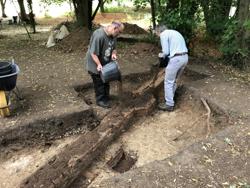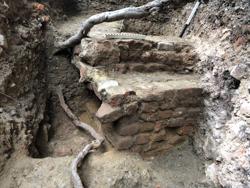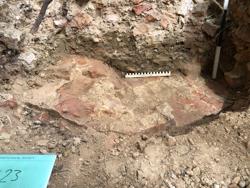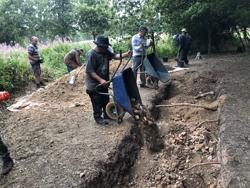22 Jul 2023
2023 Summer Dig - Day 13

It was a busy but relatively uneventful day today, on what turned out to be the final day of our two-week dig on the site of Elsyng Tudor palace, in the woods by the lime tree avenue of Forty Hall.
The dig naturally reached a point late yesterday afternoon where further significant digging would not be possible in the remaining available time, and so this morning after a few small excavation jobs we pushed on recording the final elements in Trenches 4 and 7 and were able to get the site fully backfilled and cleared before three o'clock.
Trench one was completely backfilled in the morning, followed by Trench 4. All in-situ structures were covered with topsoil first to protect them.

Trench 7 needed a bit more work, including section and elevation drawing.
In the end we were able to reveal ten courses of bricks in the truncated wall in Trench 7, laid in a rather crude header bond. This is the wall that formed the east side what we think may be a palace cellar.
We didn't reach the bottom of the wall, which is perhaps not surprising since, if the interior of the building is, as we suspect, a cellar, the wall could well extend down to the cellar floor, which is beyond our limit of safe excavation.
We suspect that the wall's truncation may have been due to the 17th century demolition crew's removal of a salvageable feature, perhaps such as a flight of stone steps leading down into the cellar.

Excavation elsewhere in the trench similarly reached the safe depth limit so we don't know how deep the mortar rich rubble layer is - if it is filling a cellar it could be at least another metre or more deep.
We were able to clean up and define the edges of the angled brick feature at the opposite end of Trench 7 - we assume it is one corner of a very substantial octagonal column, perhaps a support for a cellar ceiling, but since we only saw one corner we have no clue to its overall dimensions.
If we have found a palace cellar, this apparent column could have survived to a considerable depth, and may indicate other very well preserved elements of the building close by, not to mention the floor of the cellar itself.
This will almost certainly become at least part if not the major focus of next year's dig, as will further work on the octagonal turret in Trench 4 (once the adjacent undergrowth is cleared), to find out how the 'cellar' and turret are related.

Once everything was fully surveyed, drawn and photographed, the brick structures were also covered with a protective layer of topsoil before the trench was fully backfilled.
The long process of post-excavation work will now begin, the results of which will appear in future editions of Society News, and of course on BBC2 in the new year, when Series 11 of Digging For Britain airs.
As ever, we owe a big thank-you to all our members whose hard work and enthusiasm made this one of the most productive digs we've had in recent years.
We are most especially grateful to the core team of members who turn up every day rain or shine, and muck in with all the unglamorous and arduous tasks, of which backfilling is only one, without which the dig could not happen.
We are also particularly grateful to Forty Hall Farm for their kind provision of tool storage space and generous loan of wheelbarrows.